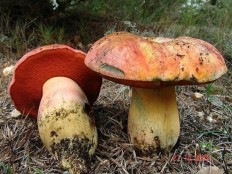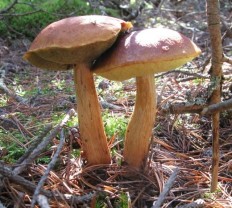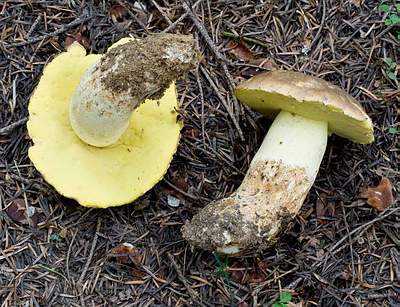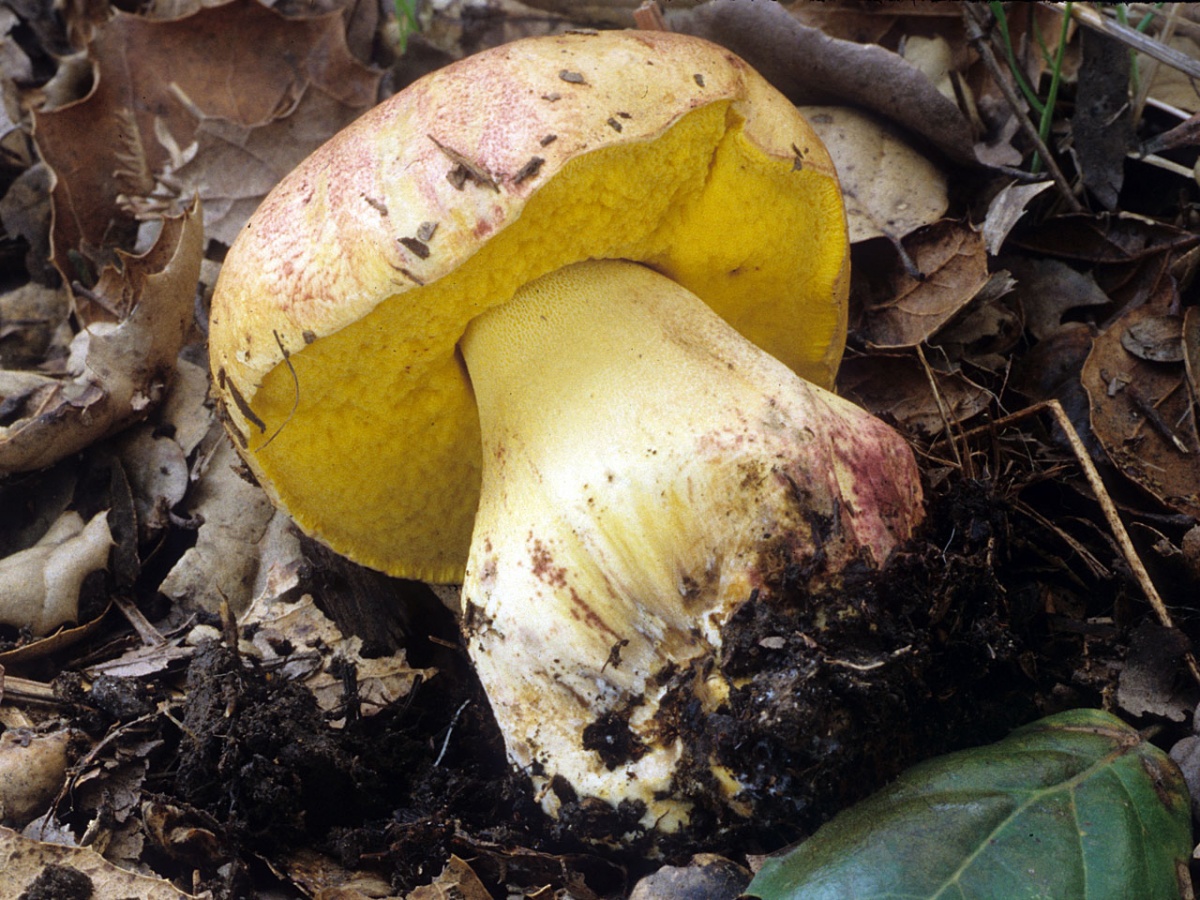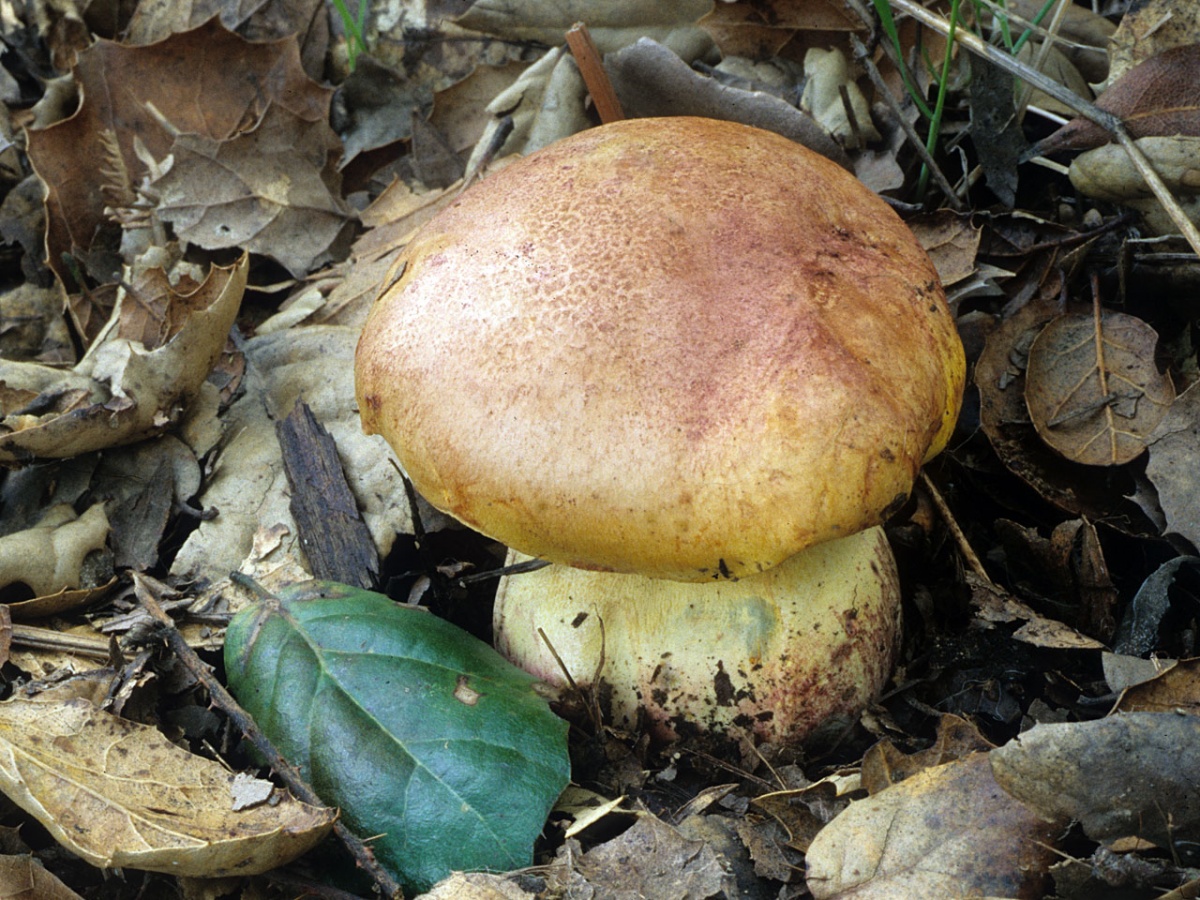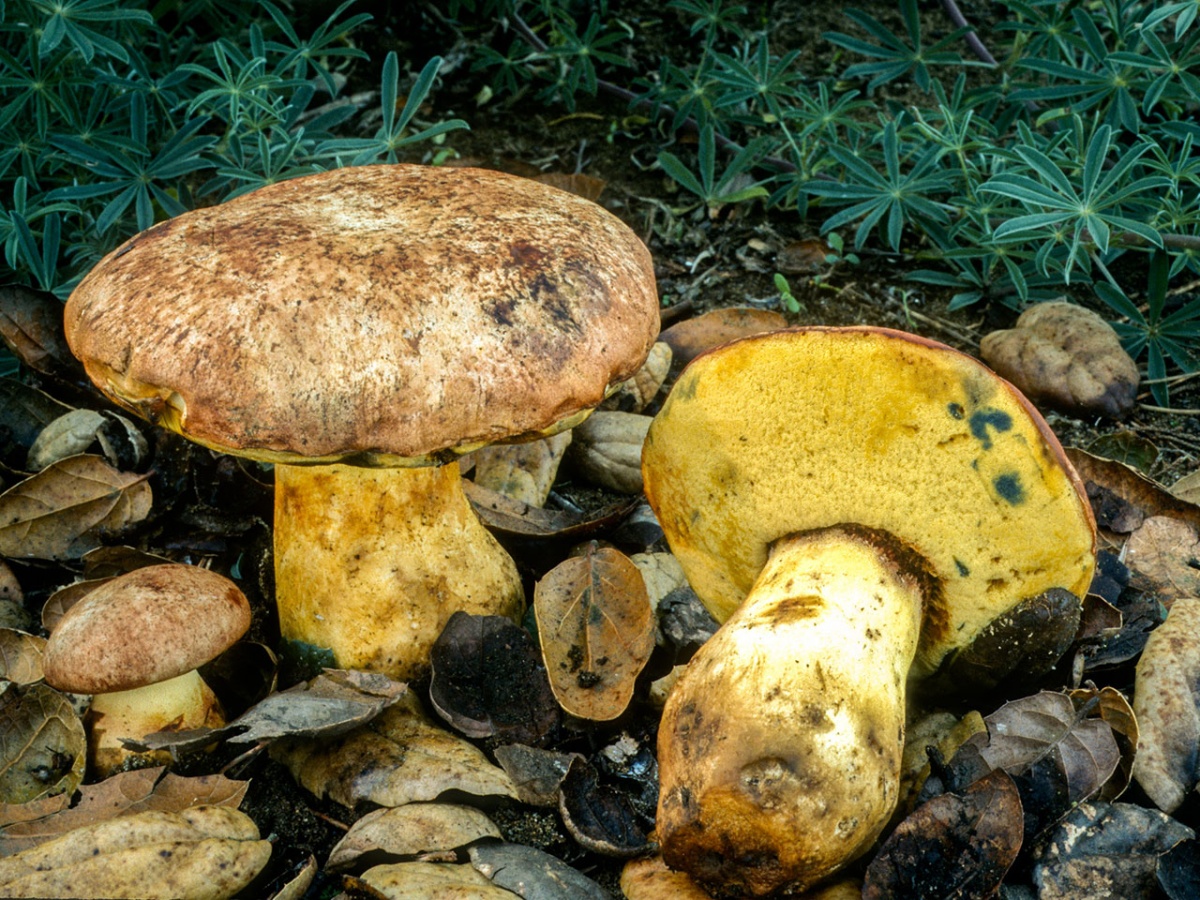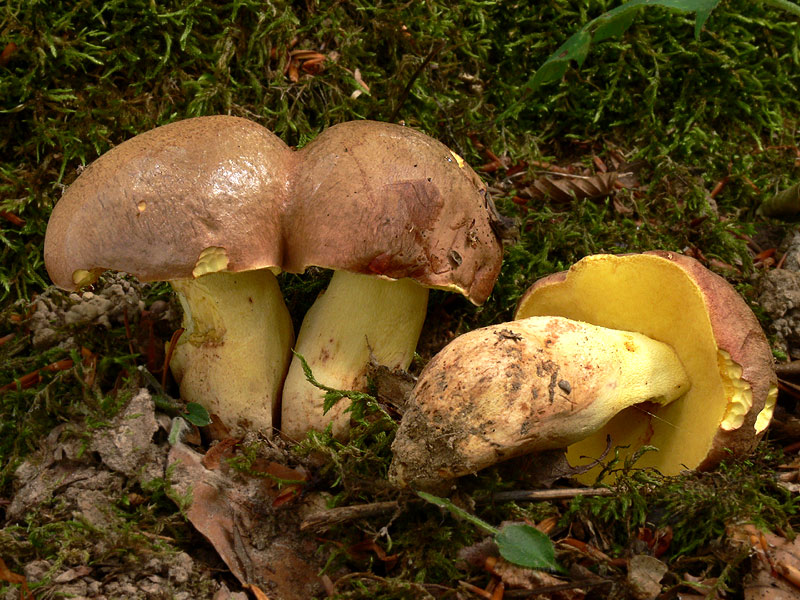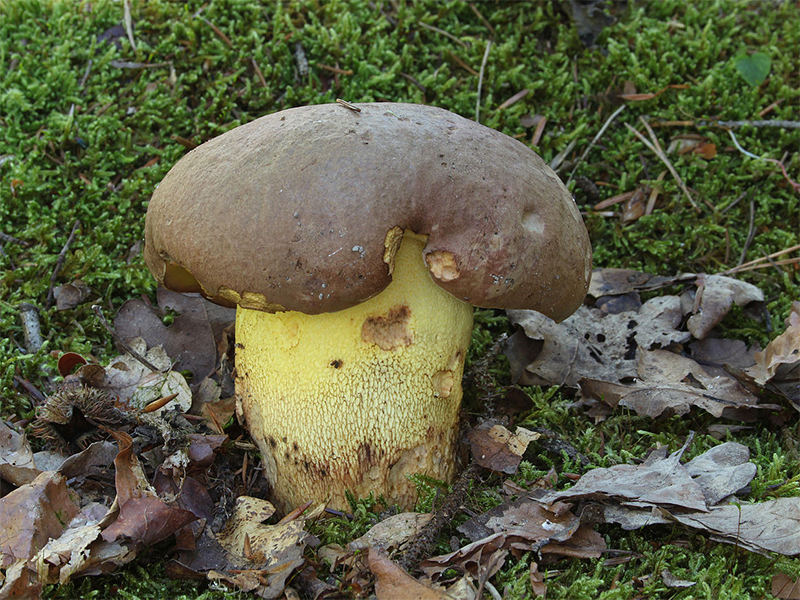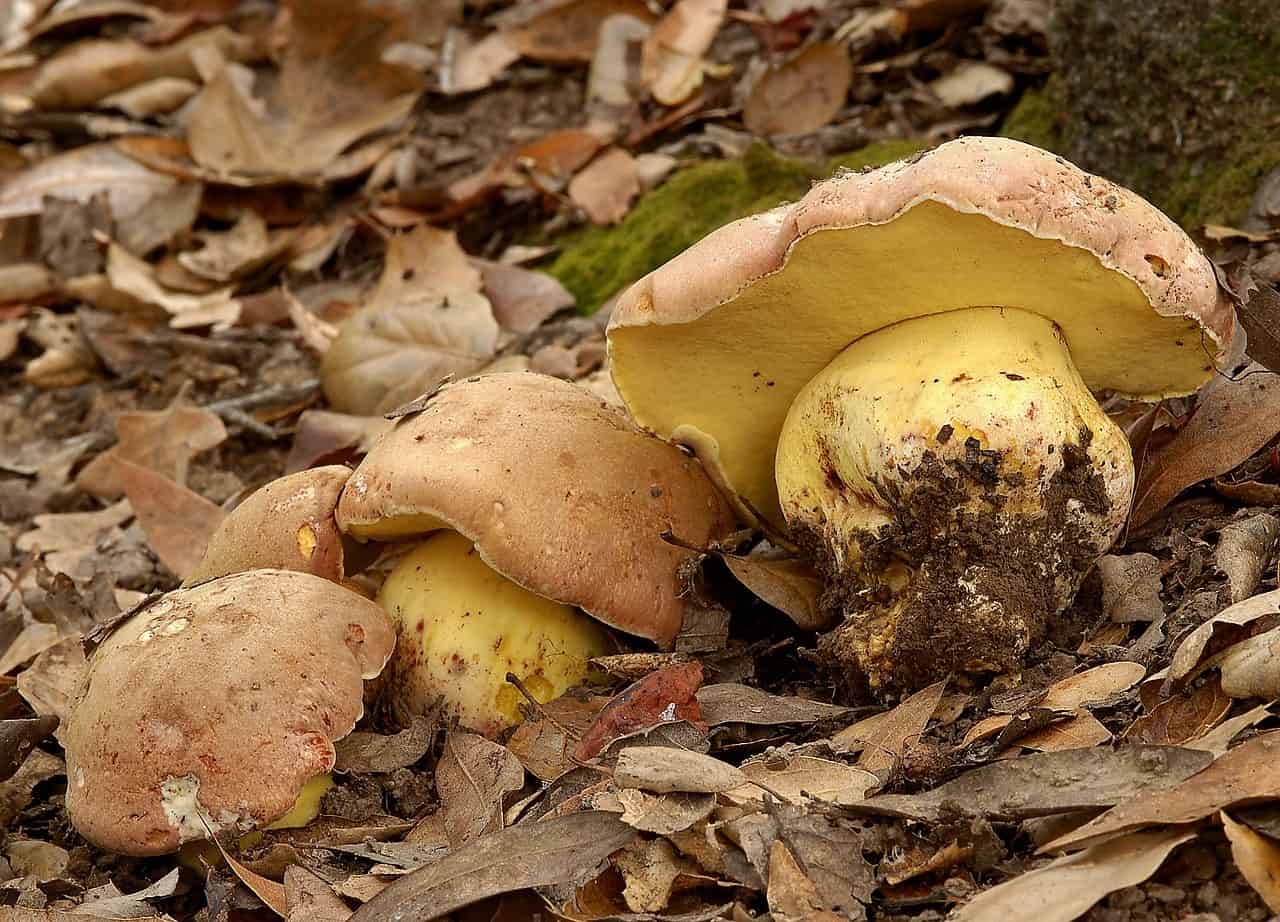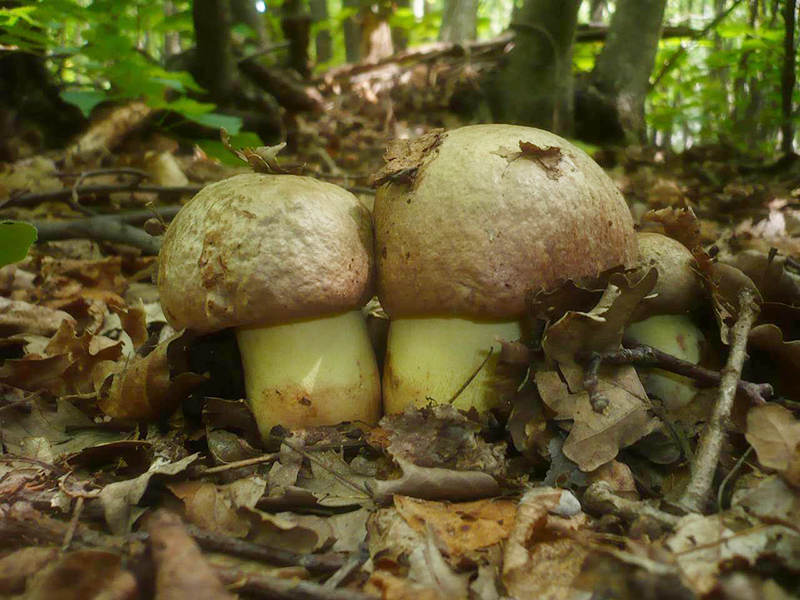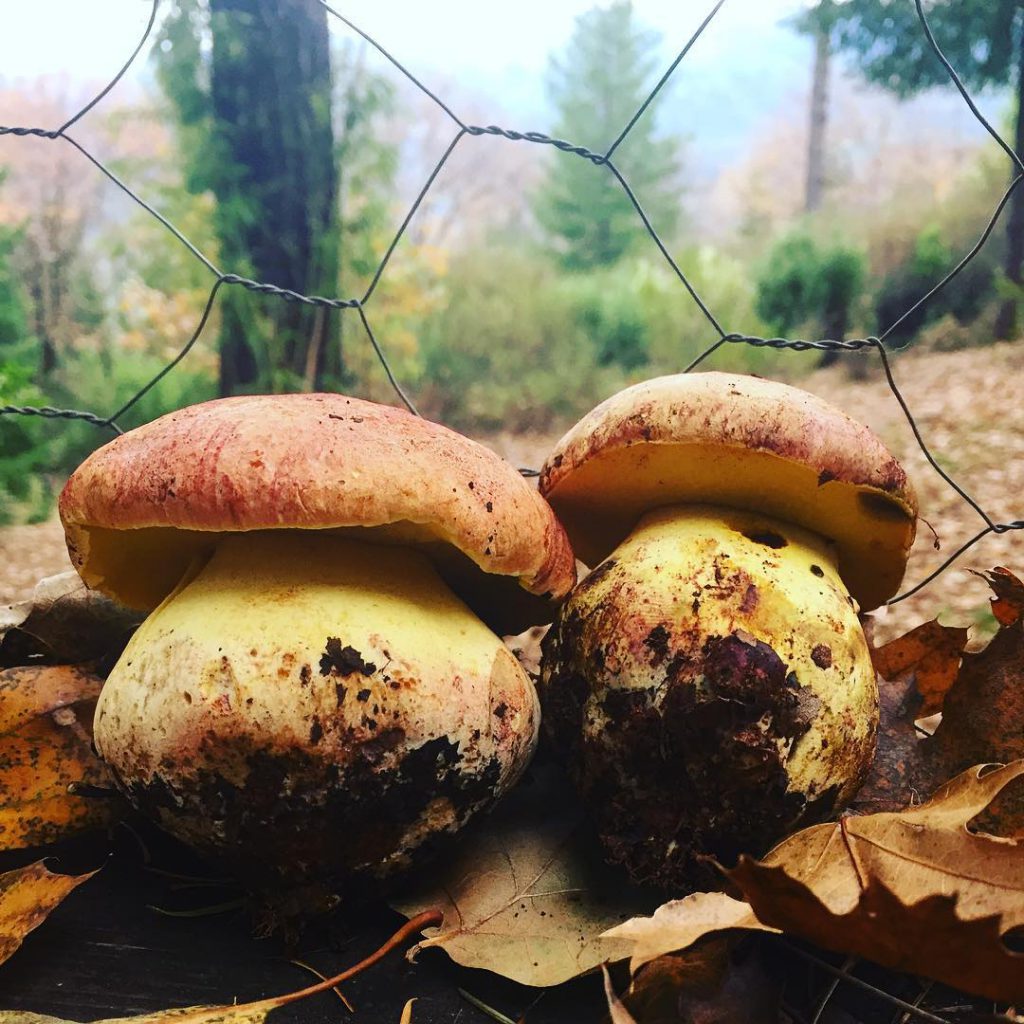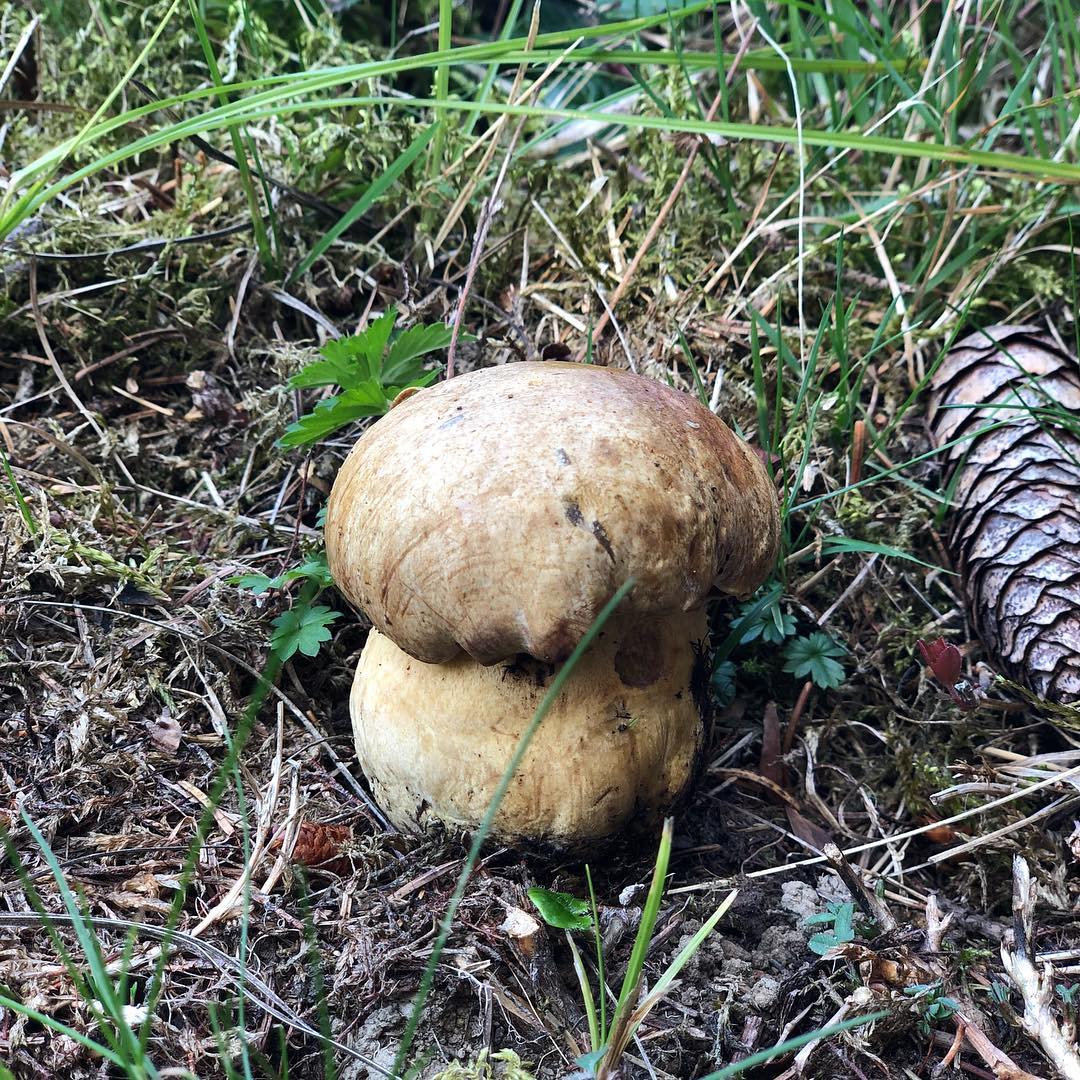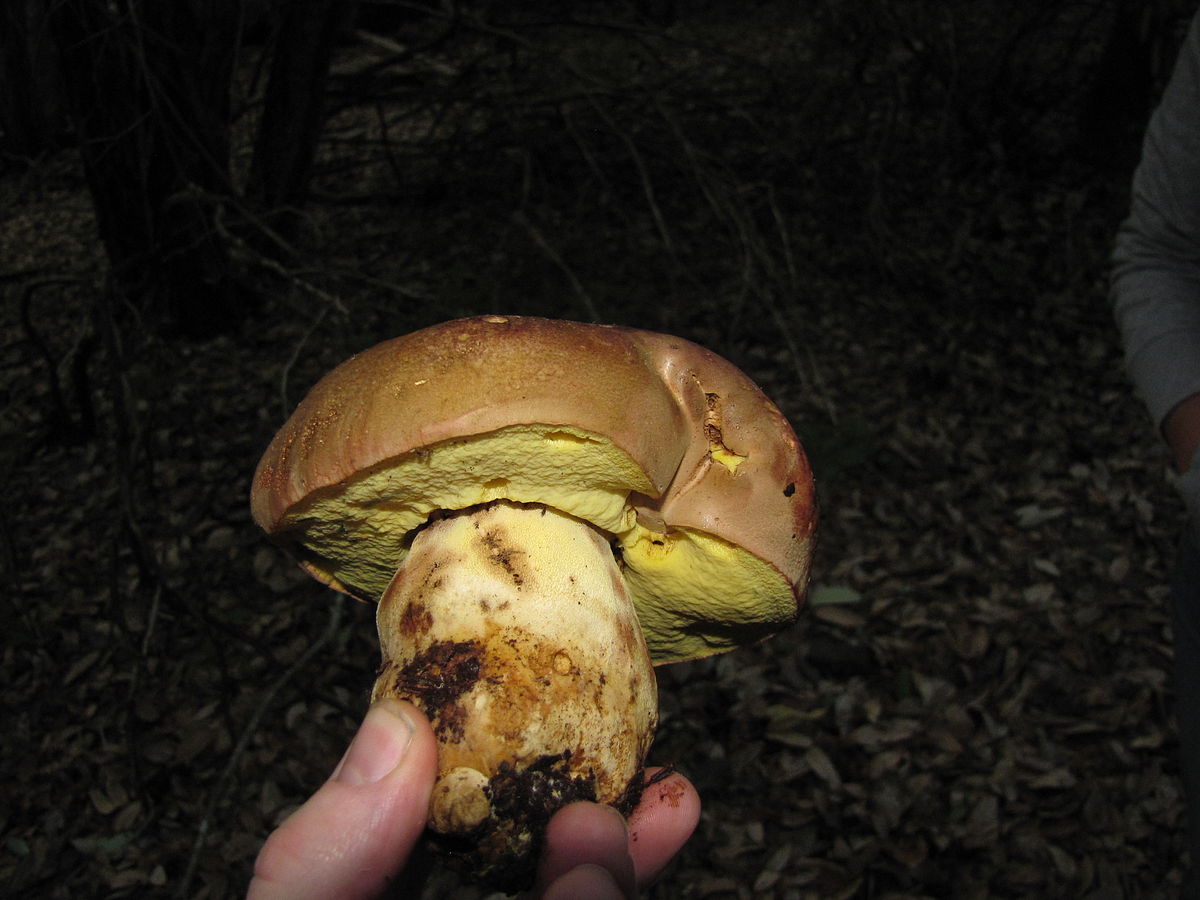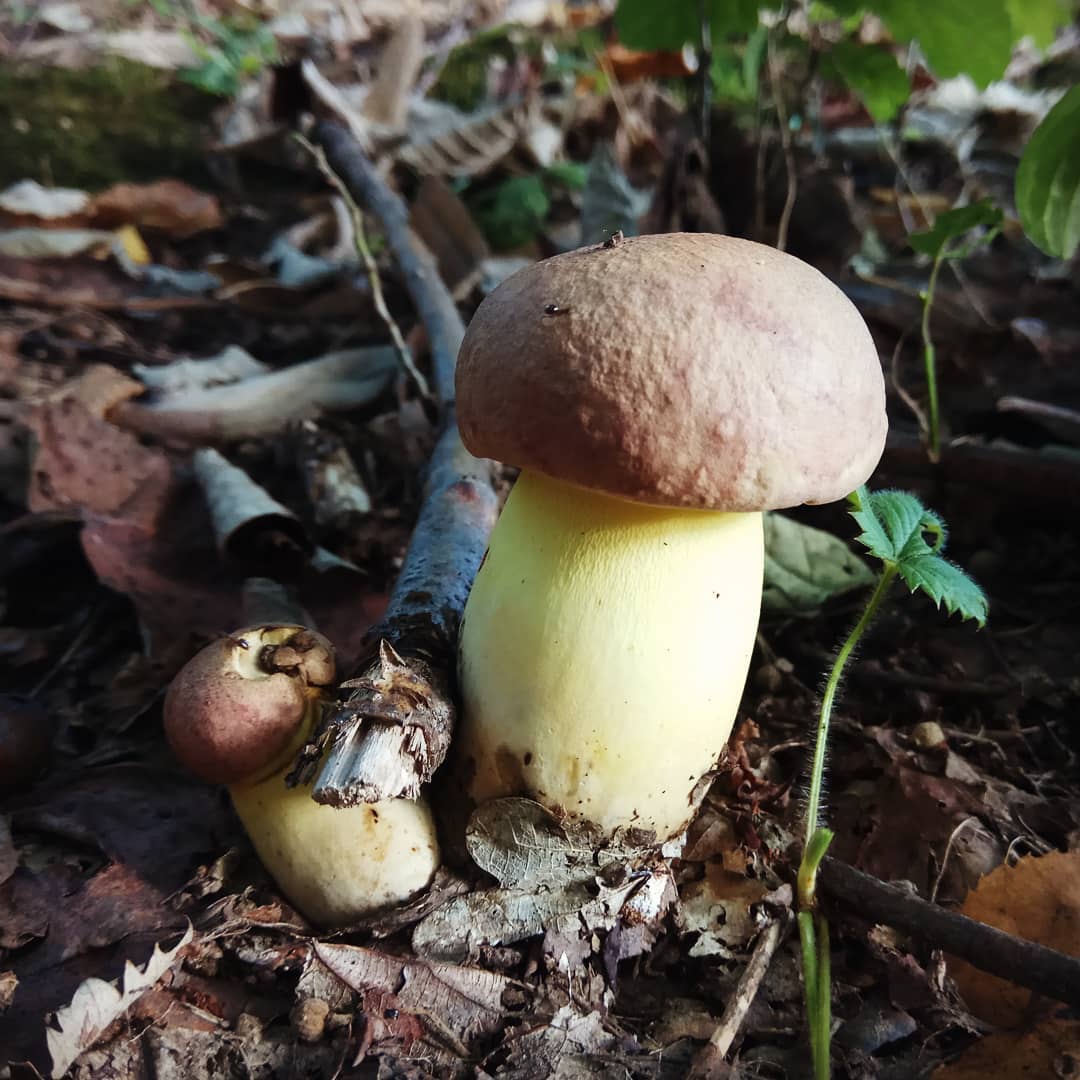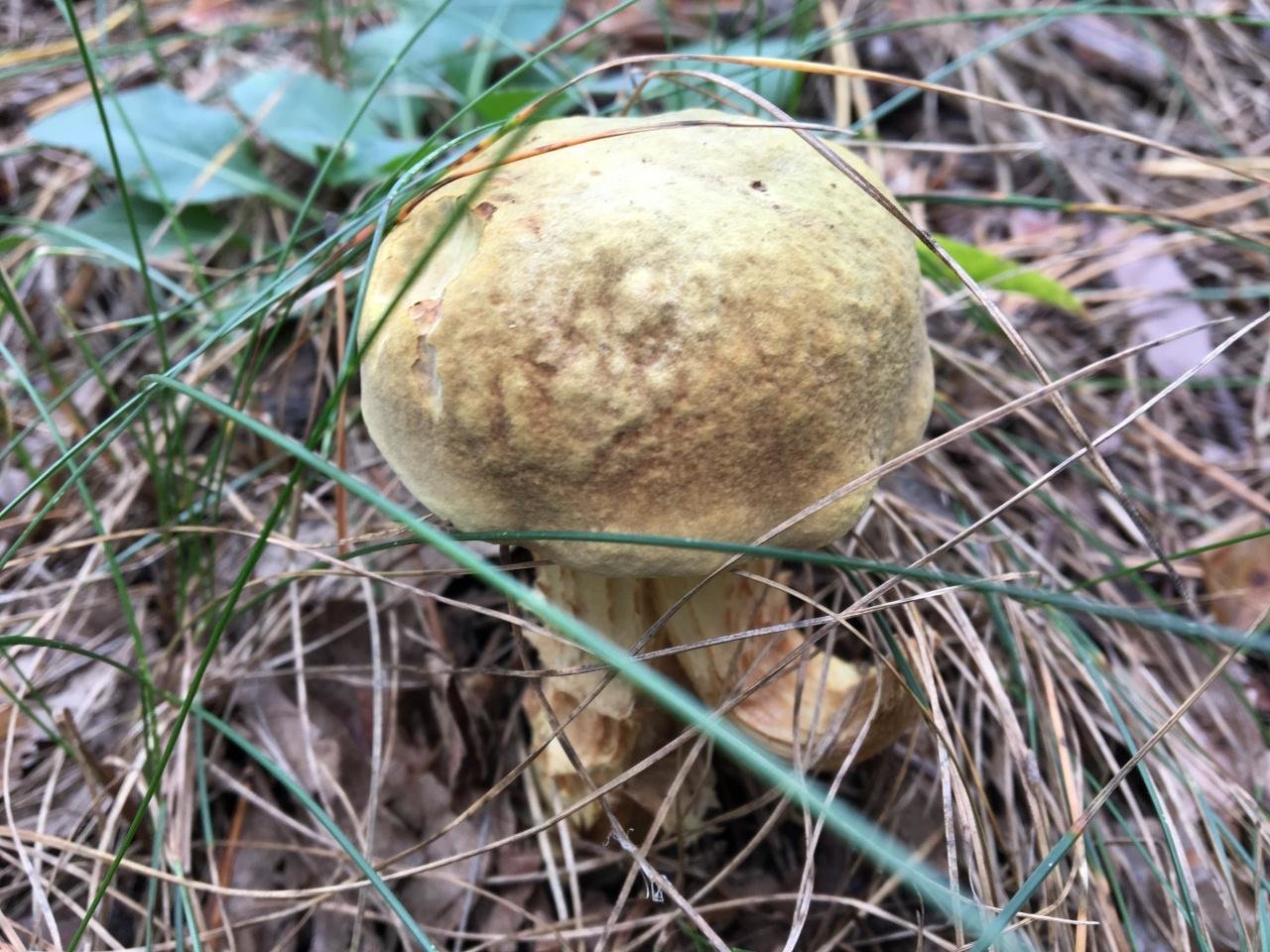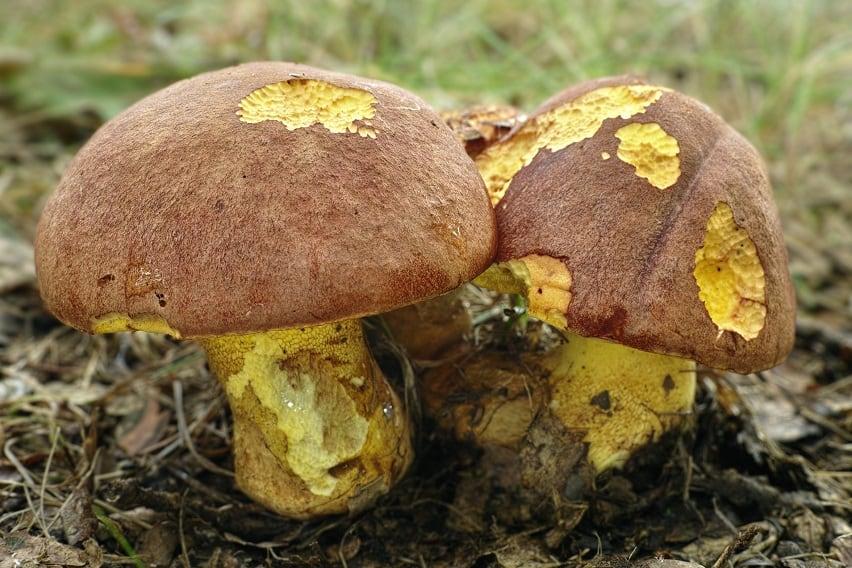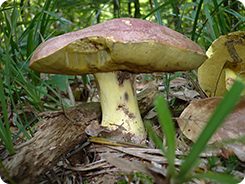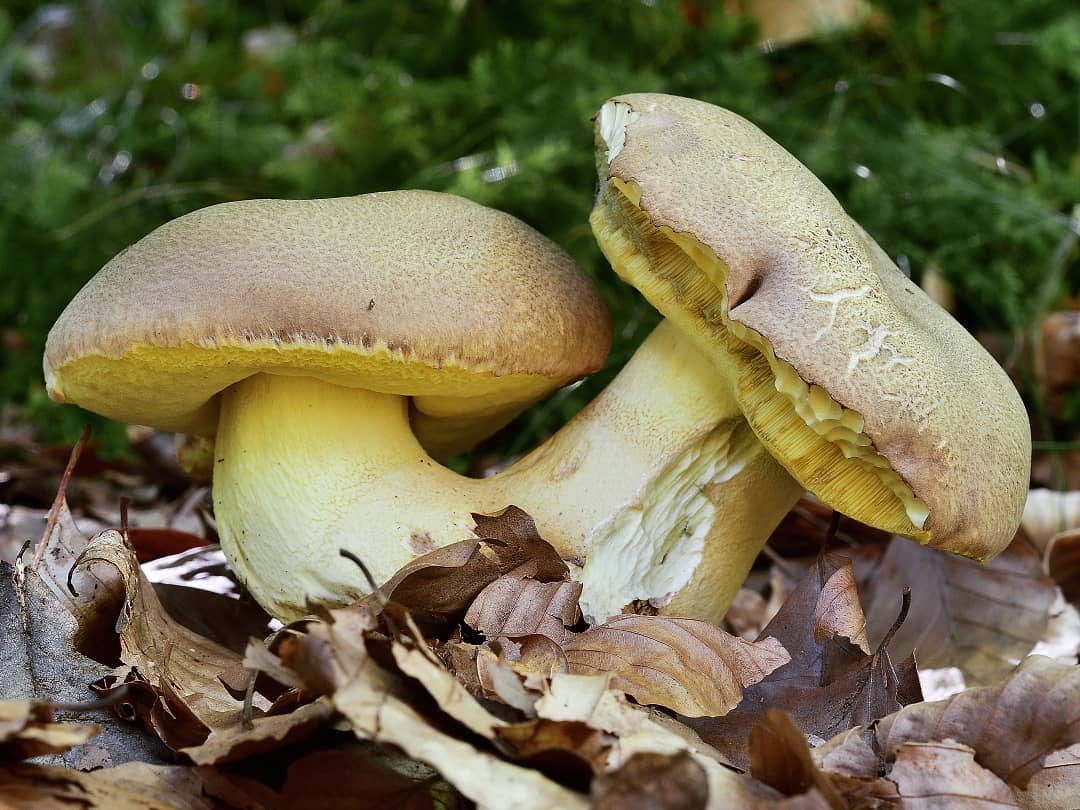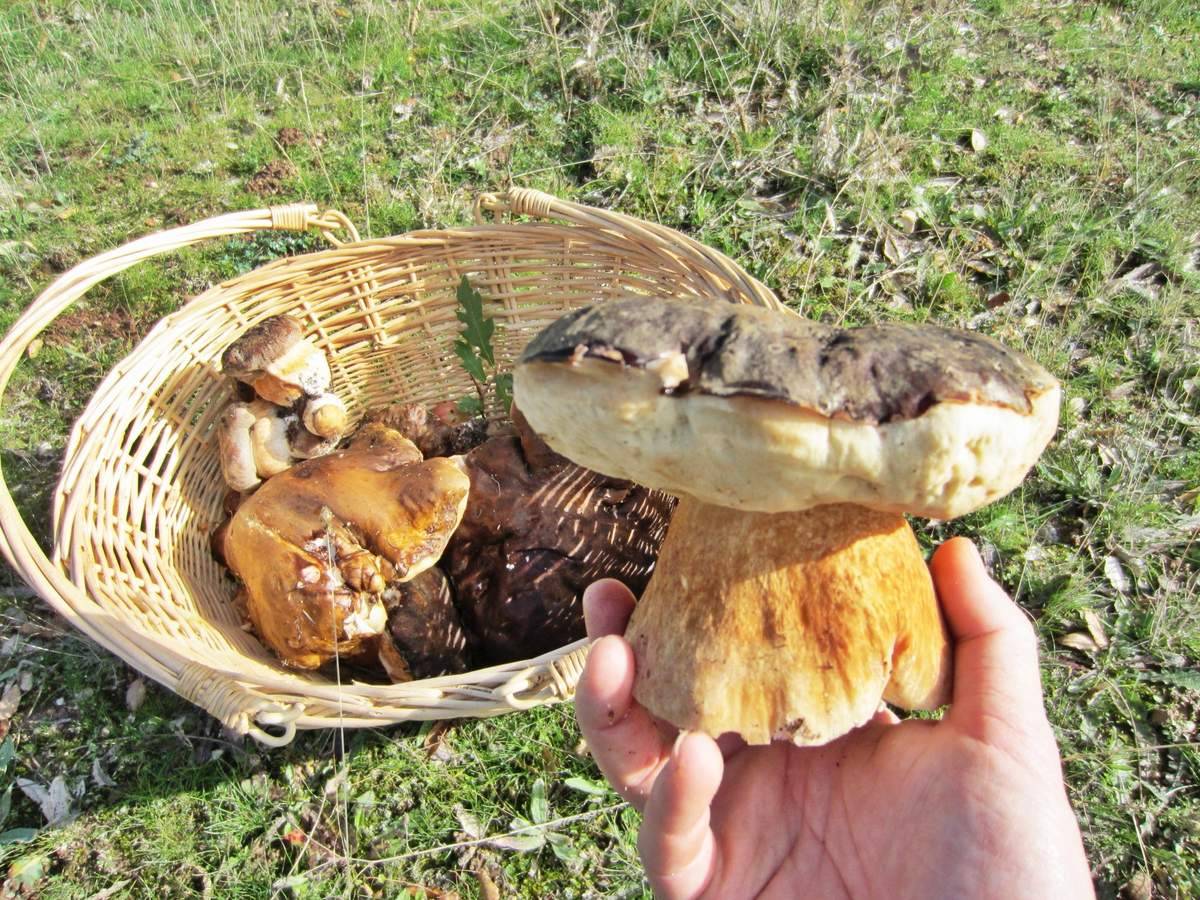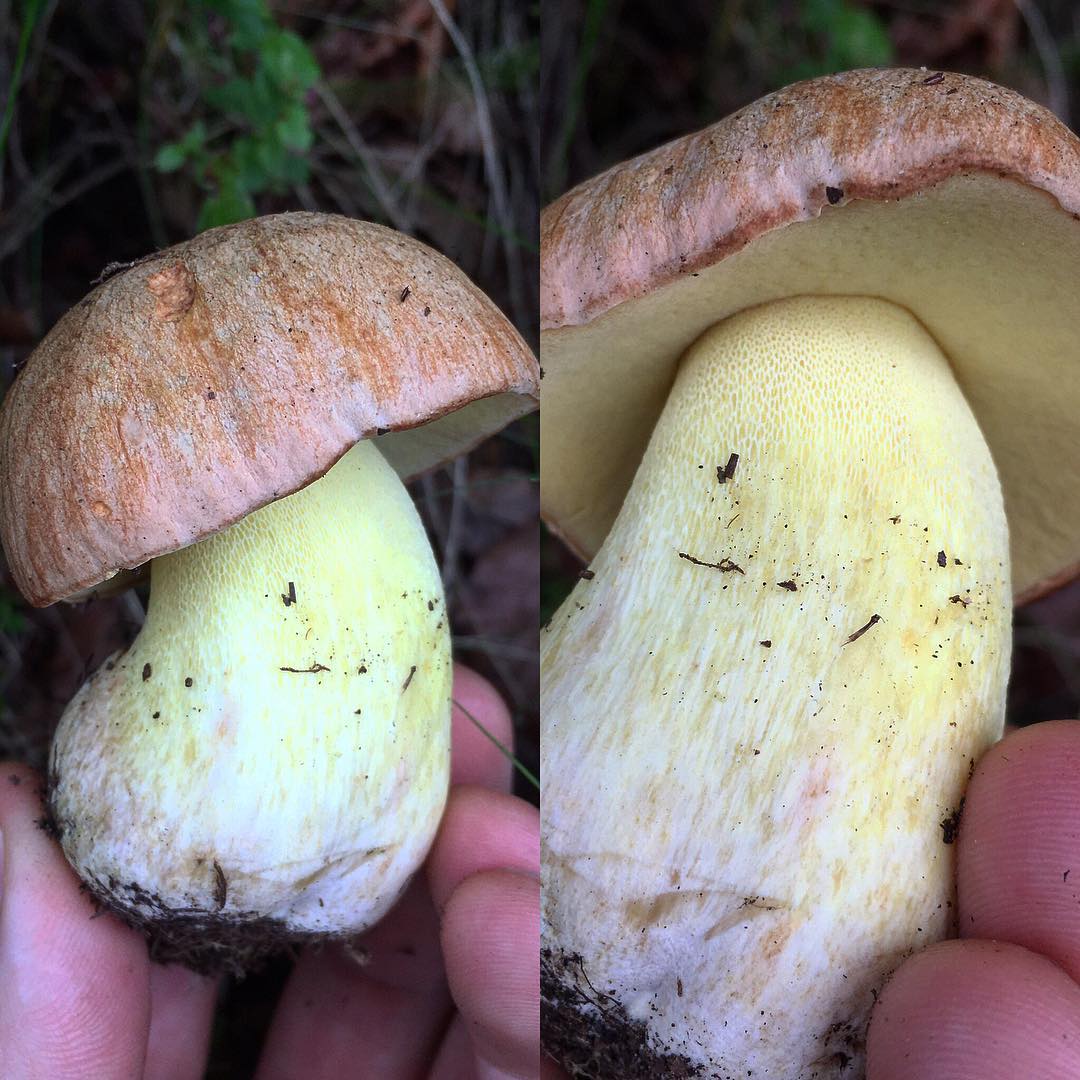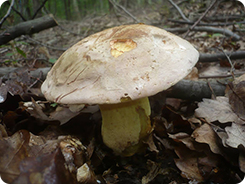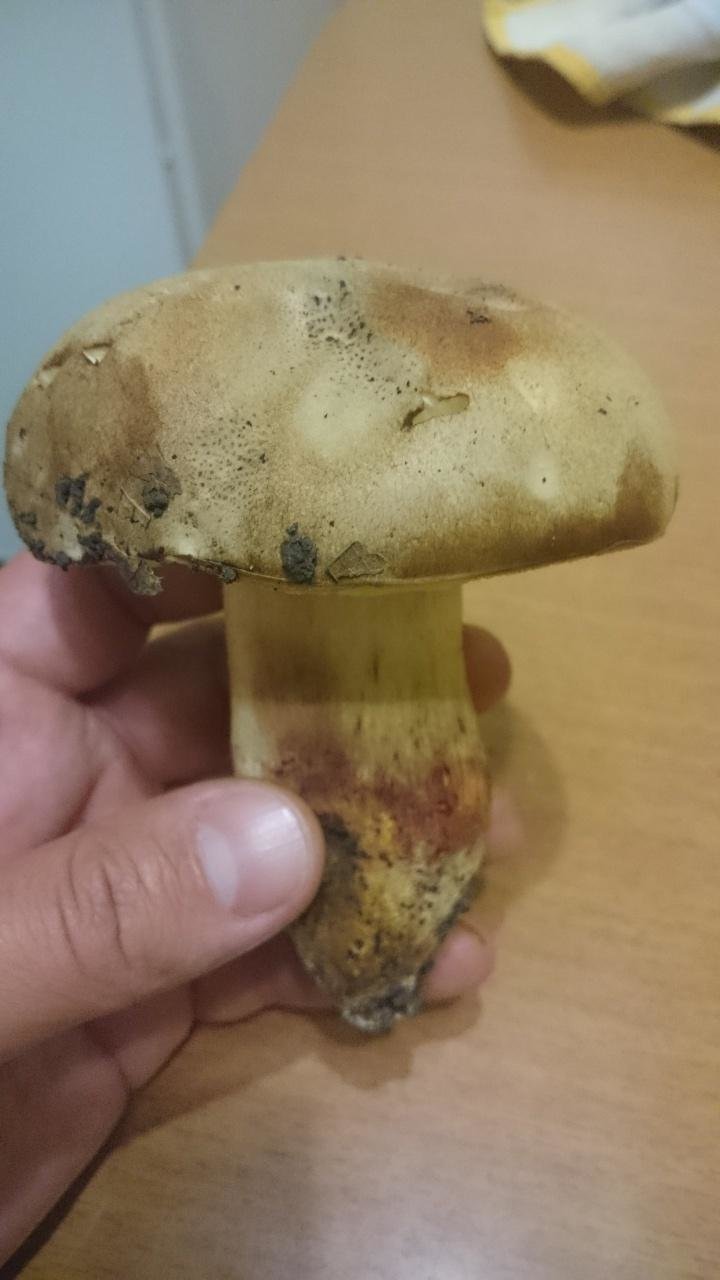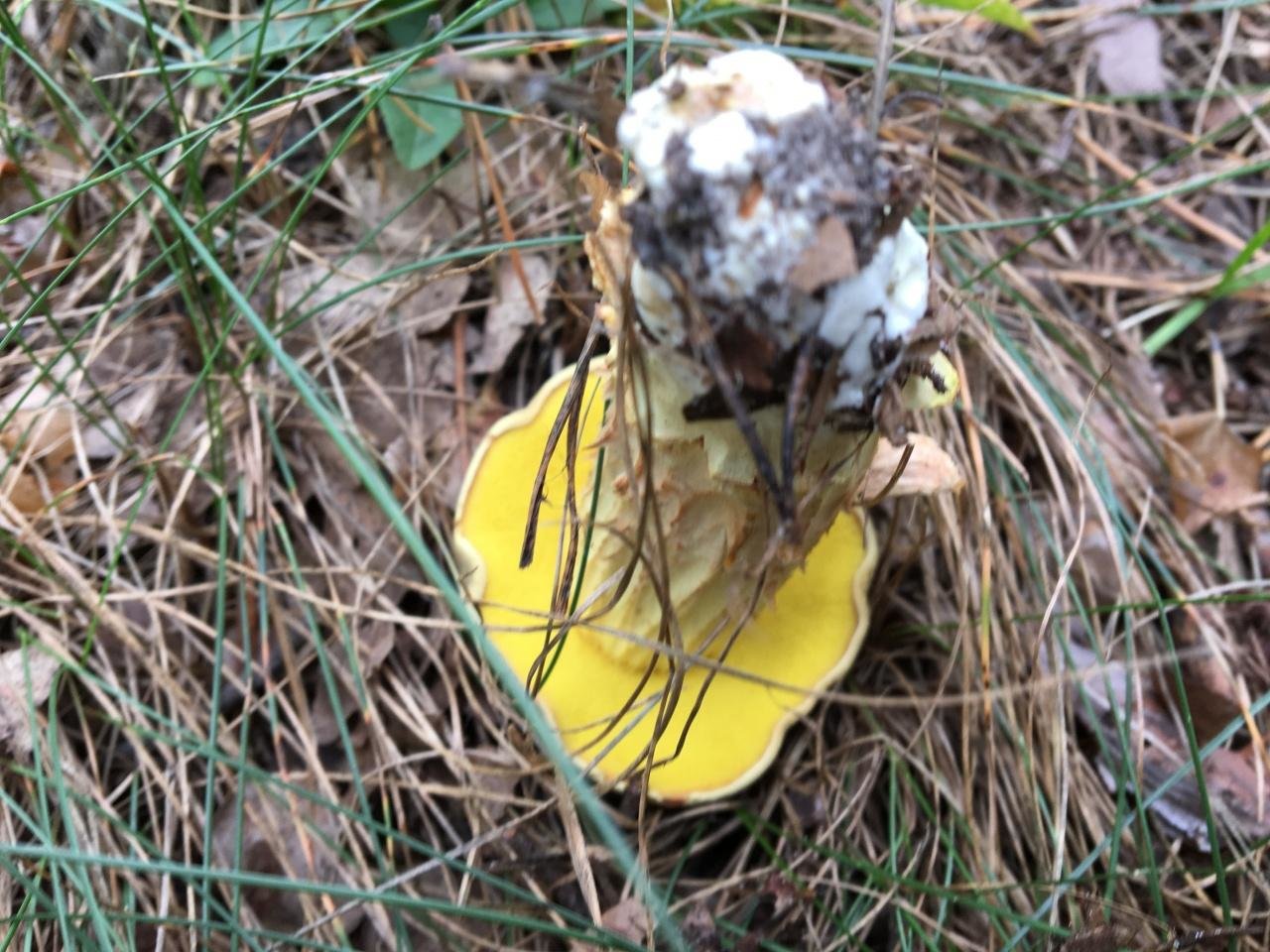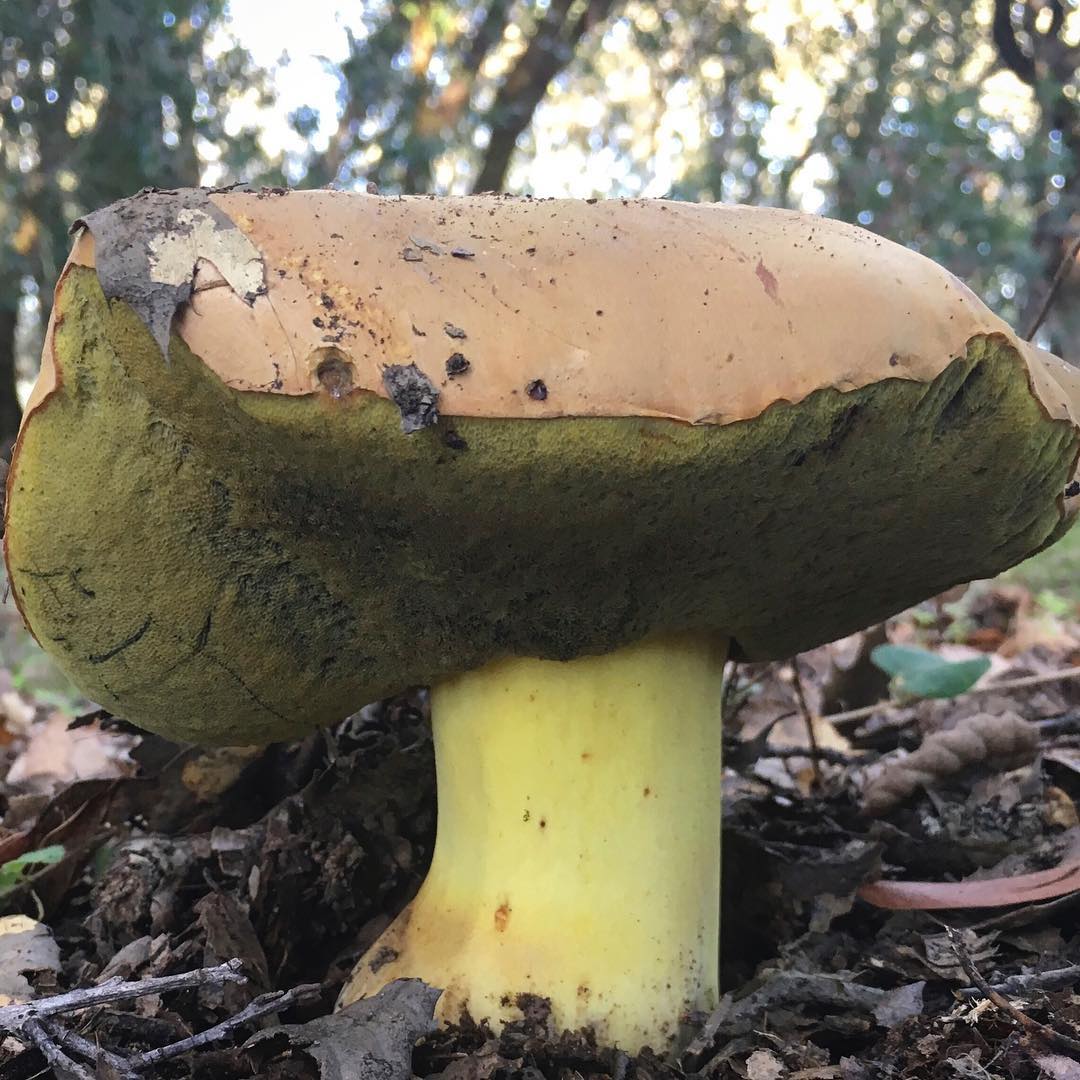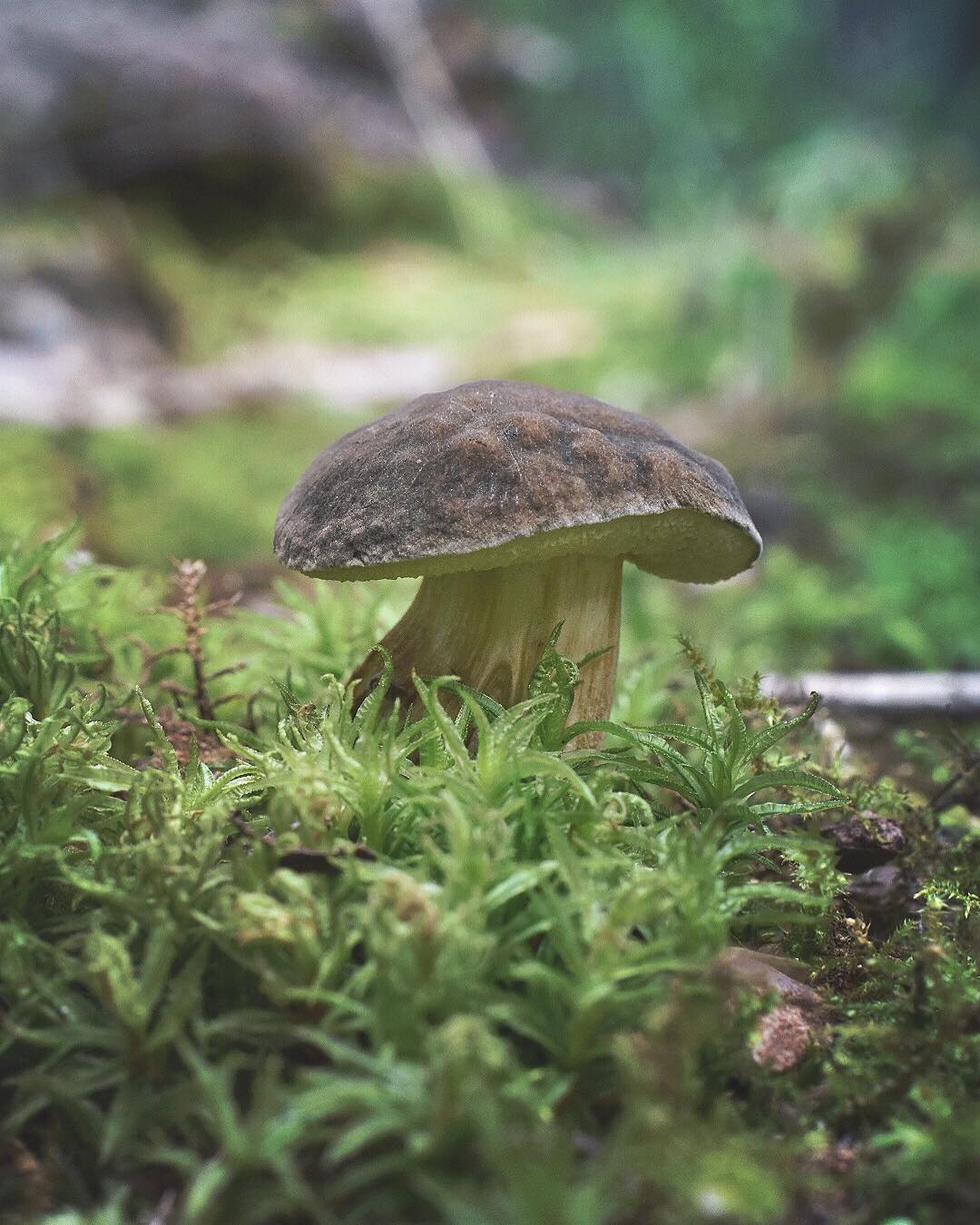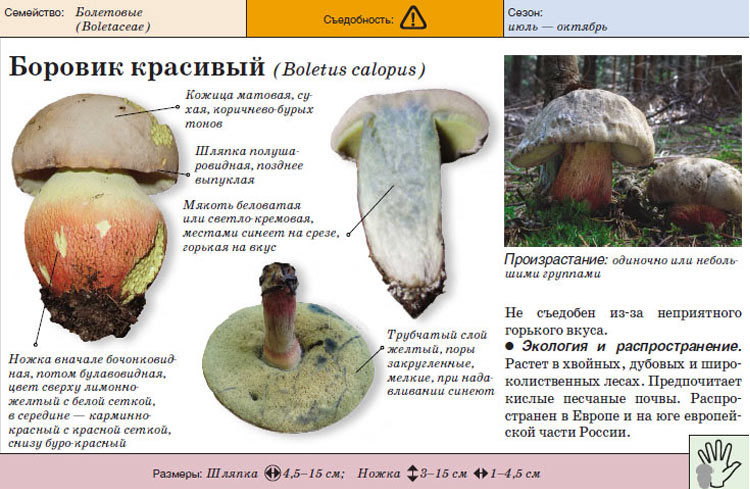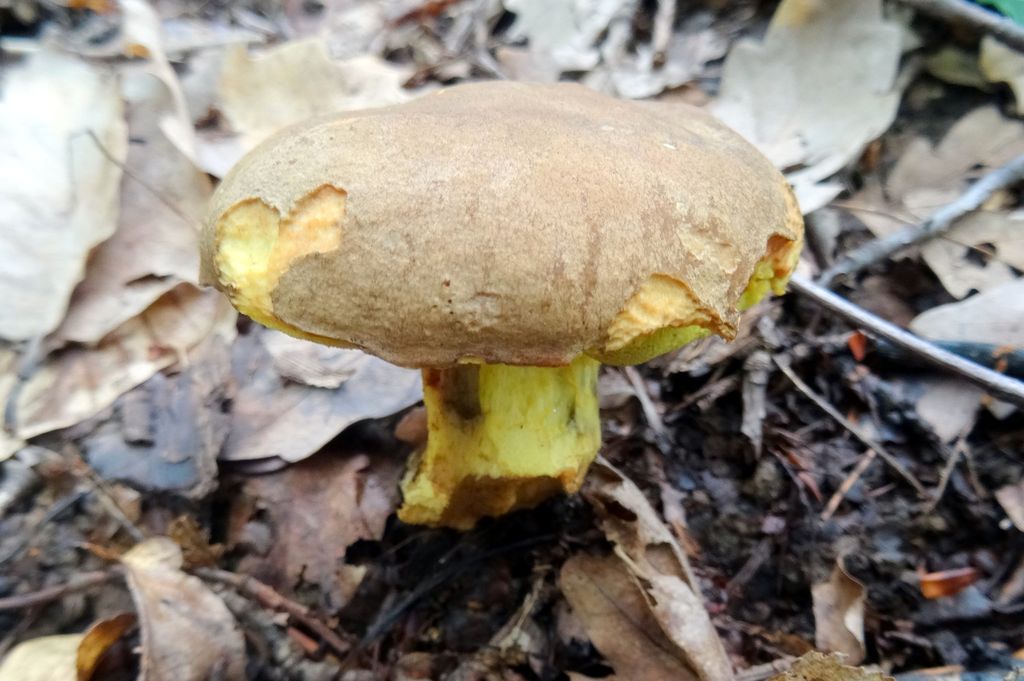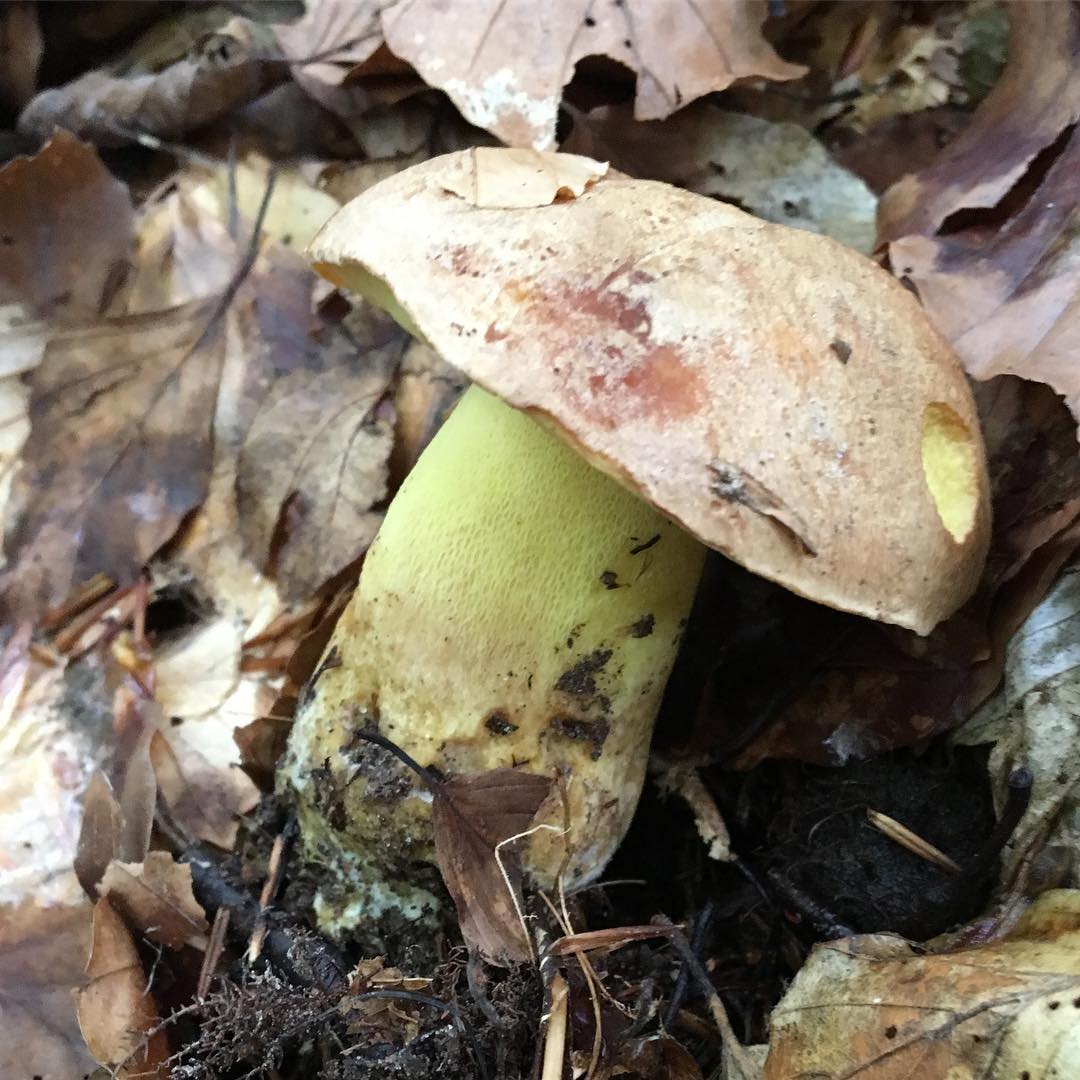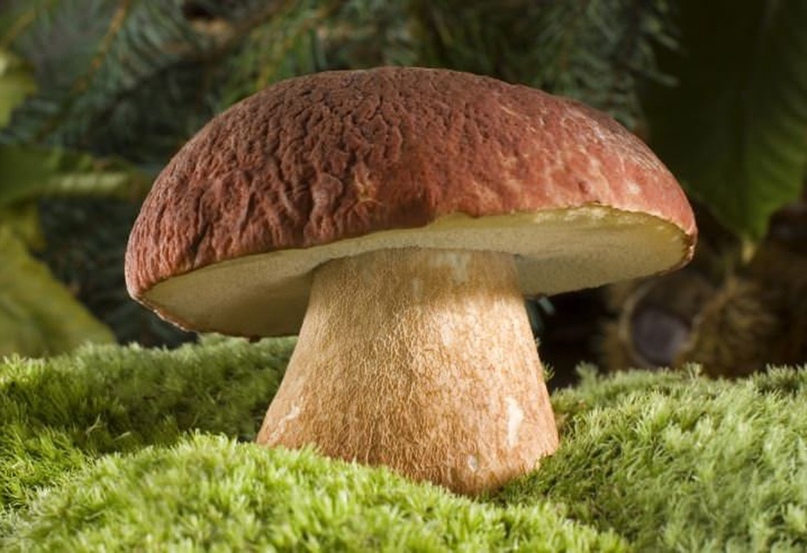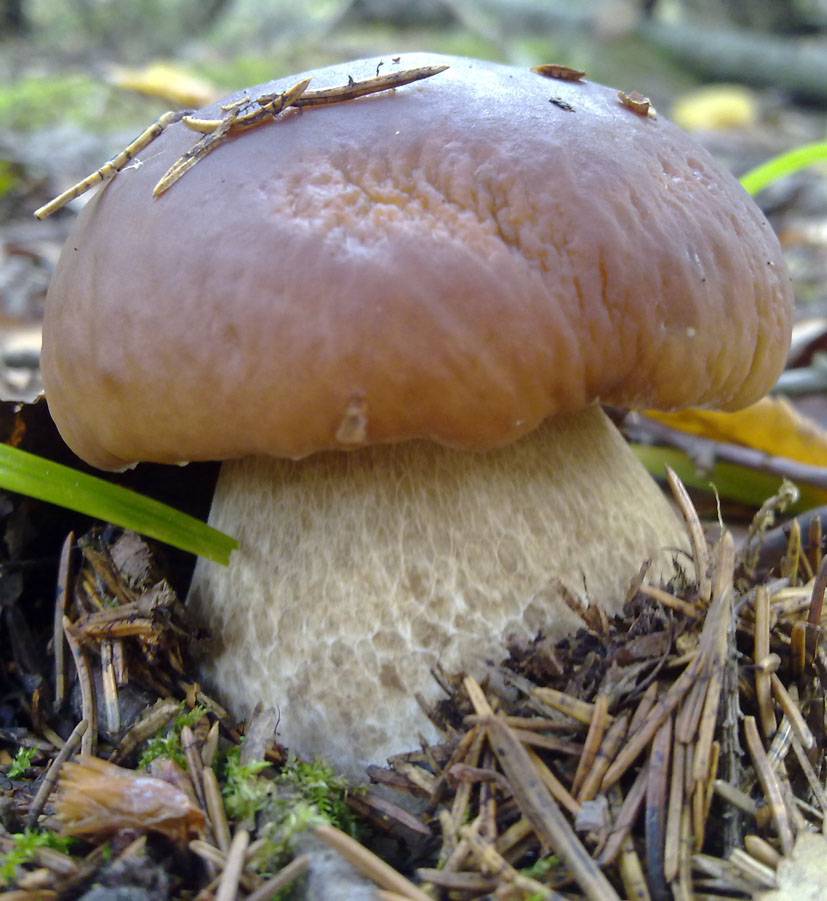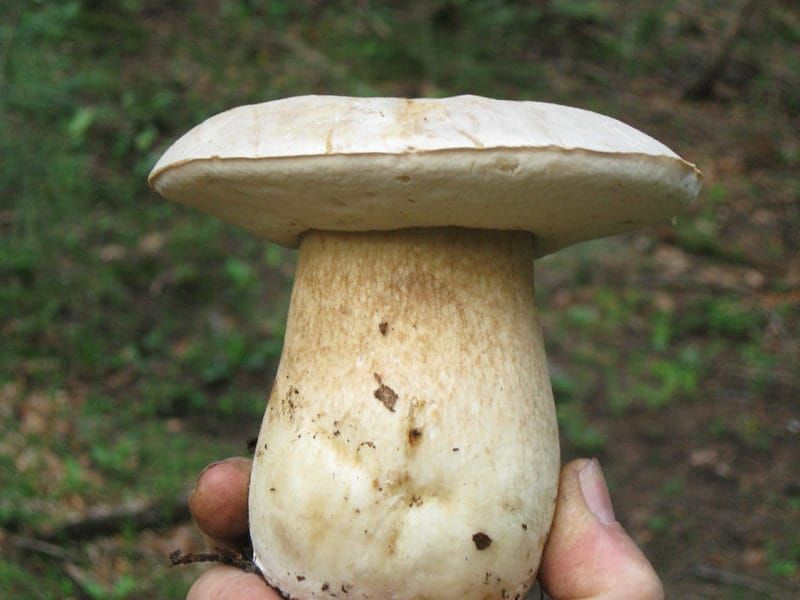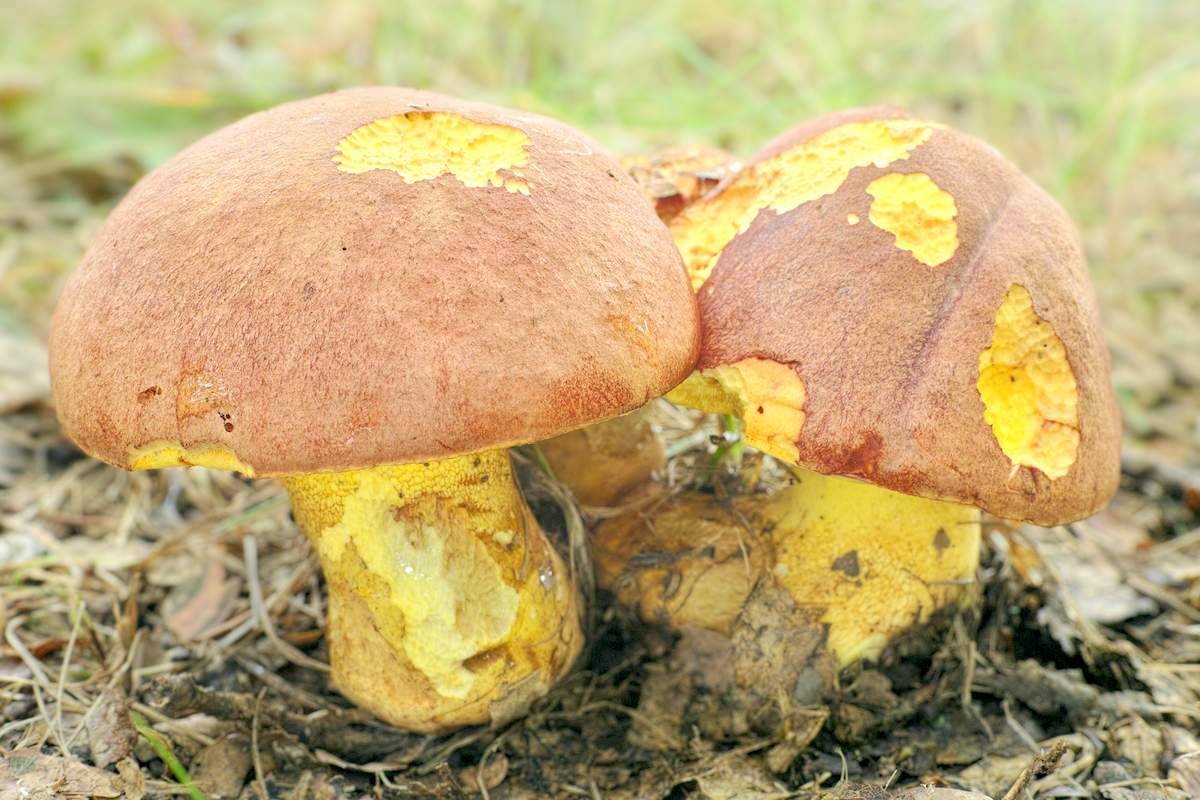Borovik subordinate (Borovik maiden)
Boletus subordinate
– Boletus appendiculatus
In another way, it is called the Ovary, the girl's Borovik, the brown Borovik - yellow, the shortened Borovik, or the reddish Borovik.
External features
Mushroom cap
The caps of these boletuses reach a diameter of 7 to 20 cm and thickness about 4 cm... In young mushrooms, they are semicircular, dull and fleecy - velvety, in more mature specimens, they are convex and smooth, covered with tightly adhered skin.
Hats are painted in brown - yellow, brown - red and brown - brown tones.
The bottom is decorated with a golden yellow (in young mushrooms), later - a golden brown tubular mass. If you press on it, it turns greenish blue.
Boletus girlish is endowed with dense bright yellow pulp that turns blue when cut.
Ripe mushrooms form smooth, elongated honey-colored spores in olive-brown spore powder.
Stipe
Legs of the Borovik subordinate, which have the shape of a club or a cylinder, reach 20-30 mm in thickness and 6-12 cm in height. The surface is covered with a mesh that disappears in mature mushrooms, and is colored lemon-yellow, the bottom becomes brown-red.
The pulp, slightly blue when touched, has a yellowish tint, closer to the ground - brownish or brownish-pink.
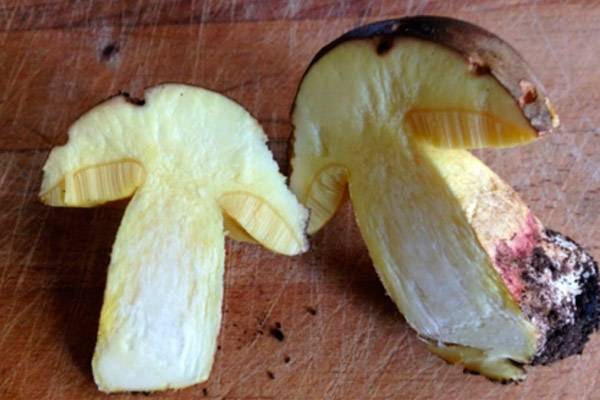
Growing places
Shortened boletus prefers moderately warm climatic conditions, limestone soils, mixed and deciduous forests with beech, hornbeam and oak. Sometimes found in mountainous areas - next to fir trees. Often found in southern European countries.
Fruiting is rare, in small clusters, occurs in June - September.
Similar species
Edible
-
Half white mushroom
... It differs from the girlish Borovik in a light ocher hat, a brown - black base of the leg and the smell of carbolic acid. -
Borovik semi-adherent
... Differs in white flesh and places of growth: prefers mountain spruce forests.
Poisonous
-
Root boletus
... The mushroom is distinguished by a light color of hats and thicker legs. -
Boletus inedible
... It is characterized by a brighter leg and a tendency towards acidic fertile soil.
The edibility of the mushroom
Borovik adnexa (Borovik maiden) exudes a pleasant mushroom aroma and has an excellent taste. It can be boiled, fried, dried, and canned.
Boletus subordinate (lat. Boletus appendiculatus
) - tubular, edible mushroom of the genus Borovik (Boletus
) families of boleths (Boletaceae
). A rare mushroom that grows from June to September, in deciduous and mixed forests.
Hat
The diameter of the cap of the Borovik subordinate is from 70 to 200 mm. At a young age, the cap of the mushroom has a semicircular shape. With age, the fungus becomes convex. The surface is velvety, matte, becomes naked with age, slightly longitudinally fibrous. The skin is practically not removed. Borovik's cap is yellow-brown, red-brown and brown-brown in color.
The tubules are dense, up to 40 mm in length. The pores are small and rounded. The color of the tubes in young mushrooms is golden yellow; with age, the mushroom becomes golden brown. When pressed, they acquire a bluish-greenish tint.
Spore powder, spores
Spores are smooth, ellipsoid-fusiform. The size of the spores is 10-15 x 4-6 microns. They are honey-yellow in color. The spore powder is olive-brown.
Leg
Leg height from 60 to 120 mm, diameter from 20 to 30 mm, cylindrical or club-shaped. The base of the stem is conically pointed, rooted in the ground. The leg of the boletus is mesh, with the age of the fungus the mesh pattern disappears. The color of the leg is closer to the cap of lemon-yellow color, to the bottom it is red-brown.
Pulp
The pulp is firm, intense yellow. At the base of the peduncle is brownish or pinkish-brown.Has a pleasant mushroom taste and aroma. Turns blue on the cut.
When and where it grows
Rare mushroom. Prefers to grow in groups of 3 to 7 pcs. The boletus is found mainly in deciduous and mixed forests from June to September. Likes to grow in regions with warm temperate climates. Forms mycorrhiza with oaks, hornbeams and beeches. Also noted in the mountains among the fir trees. Attachment to calcareous soil is noted in the literature.
Eating
Delicious edible mushroom. Suitable for all types of processing.
The boletus mushroom is one of the most common species of the Boletov family. Among the most common types of boletus are white oak mushroom (sometimes it is called net boletus), bronze boletus and girlish boletus. All these mushrooms have long been used for food, and in our times they are delicacies, since the halo of their distribution has significantly decreased.
Below you will find a photo and description of the boletus mushroom, information about the places of their growth and recommendations for the use of these mushrooms in cooking.
Description
Boletus girlish has a typical "painful" structure. Like all boletus mushrooms, this is a large and thick brownish mushroom. The adventitious boletus is a rather rare species.
The boletus boletus cap is predominantly brown, but can also be gray-yellow or reddish-brown. Small boletuses have semicircular caps; with age, their edges open, but the shape remains convex. The hat reaches a size of 20 cm in diameter and more. Its surface is always dry. In young specimens, it is covered with fluff, in old specimens it becomes smooth.
Leg
The adventitious boletus has a greenish-yellow leg, which turns reddish downward. The leg is high and moderately thick (12 * 3 cm in height and in diameter, respectively).
With mechanical action on the leg section, the latter turns blue. The bottom of the leg is pointed. The surface of the legs in young specimens is reticular; with age, the reticularity is smoothed out and becomes invisible.
Spore-bearing layer
The spore layer of the boletus is very thick, represented by tubules. The ends of the tubules (pores) are small and rounded. Young mushrooms have a yellowish tubular layer that turns brown over time. With mechanical action on the hymenophore, it locally changes color to greenish-blue.
Spore powder
The spores of the boletus maiden are large individually, resembling an asymmetrical spindle in shape, of a warm yellow hue. The surface of the spores is smooth. In the mass, the powder is greenish-brown.
Half-bronze bolette: description and photo
| Name: | Semi-bronze bolette |
| Latin name: | Boletus subaereus |
| Type of: | Edible |
| Systematics: |
|
The semi-bronze boletus is a rare mushroom with autumn fruiting. To find him in the forest, you should familiarize yourself with false doubles, study the features of his appearance.
What semi-bronze pains look like
A mushroom with a large cap, reaching up to 17-20 cm in diameter and up to 4 cm thick. In young painters, it is convex, closer in shape to a ball, but as the fruiting body grows, it straightens.
The color of the cap is gray-brown; in adults, yellowish spots appear on it. In dry hot weather, it becomes cracked.
On the underside of the cap, the tubular layer has a white color with a grayish tint. In adult representatives, it changes its color to olive green. The tubules are easily separated from the hat pulp. Their length varies from 20 to 40 mm.
The mushroom rises 12 cm above the ground, the leg reaches 40 mm in thickness. It is dense, thick, outwardly similar to a club or tuber, has a mesh pattern.As it grows, the stem becomes more cylindrical, with a wrinkled surface, pinkish-beige, and then olive-white in color.
Where semi-bronze pains grow
On the territory of the Russian Federation, pain is rare. The main place of its growth is the southern regions, where a predominantly hot climate with a large amount of precipitation. Semi-bronze boletus is more common in moist soils rich in humus.
Fruit bodies are harvested in mixed forests, where oak or beech, pine trees grow. You can find both single semi-bronze bolts and small groups of 2-3 representatives.
Taste qualities of a semi-bronze bolt
The mushroom belongs to delicacies. Gourmets appreciate it for its mild, pleasant taste. According to the comparative characteristics, the semi-bronze ache is more superior in flavor saturation and brightness to the porcini mushroom. The smell of the delicacy is weak, it appears after cooking. The aroma is well felt if the fruit body is dried.
False doubles
The semi-bronze bolt has no exact counterparts. It can be confused with other fruiting bodies in appearance.
A semi-bronze Polish mushroom looks like it hurts: the adult representatives of the species have the same cylindrical stem and a pillow-shaped cap of chocolate or chestnut shades.
To distinguish them, it is necessary to examine the fruit body: in the Polish species, the pulp is white, quickly turns blue under the influence of oxygen.
You can confuse a semi-bronze pain with a bronze boletus. That one is distinguished by a hat of a darker color and the absence of a mesh pattern on the leg.
It should be distinguished from aches and gall fungus. Gorchak has a similar structure, therefore, in order to recognize it, it is necessary to examine the leg. In the gall fungus, it has vascular veins.
Collection rules
When choosing a place, you should explore the mixed forests, visiting them in August-September. The collection point should be located far from highways and industrial facilities.
The collection should be carried out using a sharp knife: carefully cut at the root. It is not recommended to pull out or break off the fruit bodies, the risk of damage to the mycelium is high.
Use
Eating semi-bronze pain is possible in any form, except raw. Housewives, when cooking, after washing, boil the pulp, and then fry or marinate.
You can dry the fruit bodies in order to use them in future recipes.
Mushroom processing principles:
- remove all foliage and small debris from the pulp, cut off the lower part of the fruiting body, rinse under running water;
- place the mushrooms in a bowl of cold water for 15 minutes, then boil it with salt for 20 minutes, if you plan to fry the product, and 40 minutes, if the semi-bronze one hurts, you need to marinate or use it in boiled form.
Conclusion
The semi-bronze boletus is usually classified as edible mushrooms. It has a delicate aroma and mild taste, and is versatile in use. Its main habitat is mixed forests, where it should be distinguished from false species.
Growing boletus
Cultivation of boletus is a painstaking occupation that requires patience and special conditions. Due to its biological properties, the fungus needs a close connection with the root system of trees. For successful cultivation, it is necessary to plant spruce, pine or birch on the site, then you can start breeding boletus in any of three ways:
- Crushed boletus is soaked in water for a day, mixed and filtered. The finished infusion containing boletus spores is carefully distributed under the trees.
- Separate plots of land containing mycelium are dug in the forest. Small depressions are made in the soil under the trees in the garden, where the mycelium is placed and covered with forest soil. The mycelium needs moderate watering.
- The caps of overripe boletus are cut into small slices and mixed with moistened soil, and then laid out under the trees.
With timely watering for the next year, you can get a harvest: first, individual boletus, then whole families.

Similar species
The boletus maiden has both edible and inedible "analogues".

Edible counterparts:
Its difference is in a lighter hat and a black base of the leg. The smell is also different (it resembles carbolic acid).
Borovik semi-adherent
Unlike boletus, the flesh of this mushroom is not yellow, but white. In addition, it grows in thickets of firs.
Among the inedible mushrooms, there are also additional boletus-like mushrooms:
Root boletus
This mushroom is thicker and lighter in color. It is considered inedible, since it has a pronounced bitterness in taste, which cannot be eliminated either by soaking or digestion. For this reason, the mushroom is also called bitter;
Also referred to as "inedible." It has a brighter leg (its upper half is yellow, and the lower half is red). Like the rooted boletus, it is inedible because of its invincible bitterness.

Poisonous analogues are not observed in the boletus. Therefore, the only thing that can happen is picking a tasteless mushroom, which is certainly unpleasant, but does not threaten life and health.
Poisonous boletus - varieties
Among the 300 known species of boletus, there are inedible, as well as hazardous to health representatives, similar to edible boletus:
boletus purple (Boletus purpureus)
a poisonous mushroom with a characteristic convex cap with uneven edges, covered with black spots. The pulp on the cut turns blue, and after a while it turns red. The fungus grows on the calcareous soil of deciduous forests;
Photo by: Irina Ukhanova
boletus Le Gal (Boletus legaliae)
a poisonous, toxic mushroom, characterized by a smooth pinkish-orange head. There is a pronounced red mesh on the upper half of the leg. The pulp is white or light yellow, turns blue on the cut. Grows in deciduous forests of Europe;
beautiful boletus (beautiful) (Boletus calopus)
an inedible mushroom, with a wrinkled, dry, matte cap. The pointed leg is lemon yellow at the top, red in the middle, turning into brown. The pulp has a bitter taste and turns blue on the cut. It is found everywhere in the mixed forests of the European part of Russia;
beautiful boletus (Boletus pulcherrimus)
poisonous mushroom. The hat is hemispherical and has a reddish or olive brown color. The pulp is yellow, turns blue on the cut. The leg is reddish brown, has a dark red mesh below;
satanic mushroom (Boletus satanas)
poisonous mushroom. The cap is hemispherical, the flesh is yellowish or white, turns red or blue on the cut. The leg is barrel-shaped, tapering downward. The color of the leg is red-yellowish above, bright red or orange in the middle, brownish-yellow below. The satanic mushroom grows in deciduous forests.
| Name: | Borovik |
| Type of: | Edible |
A photo and description of the boletus mushroom can often be found both in specialized literature and in many cookbooks. Few people compare in popularity with this representative of the mushroom kingdom, especially in Russia. Borovik is deservedly considered one of the most coveted trophies among mushroom pickers, not inferior in this to such "royal" mushrooms as camelina or white milk mushroom.
Borovik subordinate (Borovik maiden)
Boletus subordinate
– Boletus appendiculatus
In another way it is called the Ovary, the girl's boletus, the brown boletus - yellow, the shortened boletus, or the reddish boletus.
External features
Mushroom cap
The caps of these boletus mushrooms reach a diameter of 7 to 20 cm and a thickness of about 4 cm. In young mushrooms, they are semicircular, dull and fleecy - velvety, in more mature specimens they are convex and smooth, covered with tightly adhered skin.
Hats are painted in brown - yellow, brown - red and brown - brown tones.
The bottom is decorated with a golden yellow (in young mushrooms), later - a golden brown tubular mass. If you press on it, it turns greenish blue.
Boletus girlish is endowed with dense bright yellow pulp that turns blue when cut.
Ripe mushrooms form smooth, elongated honey-colored spores in olive-brown spore powder.
Stipe
Legs of the Borovik subordinate, having the shape of a club or a cylinder, reach 20-30 mm in thickness and 6-12 cm in height. The surface is covered with a mesh that disappears in mature mushrooms, and is colored lemon-yellow, the bottom becomes brown-red.
The flesh, slightly blue when touched, has a yellowish tint, closer to the ground - brownish or brownish-pink.

Growing places
Shortened boletus prefers moderately warm climatic conditions, limestone soils, mixed and deciduous forests with beech, hornbeam and oak. Sometimes found in mountainous areas - next to fir trees. Often found in southern European countries.
Fruiting is rare, in small clusters, occurs in June - September.
Similar species
Edible
-
Half white mushroom
... It differs from the girlish Borovik in a light ocher hat, brown - black base of the leg and the smell of carbolic acid. -
Borovik semi-adherent
... Differs in white flesh and places of growth: prefers mountain spruce forests.
Poisonous
-
Root boletus
... The mushroom is distinguished by a light color of hats and thicker legs. -
Boletus inedible
... It is characterized by a brighter leg and a tendency towards acidic fertile soil.
The edibility of the mushroom
Borovik adnexa (Borovik maiden) exudes a pleasant mushroom aroma and has an excellent taste. It can be boiled, fried, dried, and canned.
Boletus subordinate (lat. Boletus appendiculatus
) - tubular, edible mushroom of the genus Borovik (Boletus
) families of boleths (Boletaceae
). A rare mushroom that grows from June to September, in deciduous and mixed forests.
Hat
The diameter of the cap of the Borovik subordinate is from 70 to 200 mm. At a young age, the cap of the mushroom has a semicircular shape. With age, the fungus becomes convex. The surface is velvety, matte, becomes naked with age, slightly longitudinally fibrous. The skin is practically not removed. Borovik's cap is yellow-brown, red-brown and brown-brown in color.
The tubules are dense, up to 40 mm in length. The pores are small and rounded. The color of the tubes in young mushrooms is golden yellow; with age, the mushroom becomes golden brown. When pressed, they acquire a bluish-greenish tint.
Spore powder, spores
Spores are smooth, ellipsoid-fusiform. The size of the spores is 10-15 x 4-6 microns. They are honey-yellow in color. Spore powder, olive brown.
Leg
Leg height from 60 to 120 mm, diameter from 20 to 30 mm, cylindrical or club-shaped. The base of the stem is conically pointed, rooted in the ground. The leg of the boletus is mesh, with the age of the fungus the mesh pattern disappears. The color of the leg is closer to the cap of lemon-yellow color, to the bottom it is red-brown.
Pulp
The pulp is firm, intense yellow. At the base of the peduncle is brownish or pinkish-brown. Has a pleasant mushroom taste and aroma. Turns blue on the cut.
When and where it grows
Rare mushroom. Prefers to grow in groups of 3 to 7 pcs. The boletus is found mainly in deciduous and mixed forests from June to September. Likes to grow in regions with warm temperate climates. Forms mycorrhiza with oaks, hornbeams and beeches. It is also noted in the mountains among the fir trees. Attachment to calcareous soil is noted in the literature.
Delicious edible mushroom. Suitable for all types of processing.
Description of boletus adnexa
The diameter of the boletus cap is 7-20 centimeters. The shape of the cap in young specimens is semicircular, becoming convex over time. The cap has a thick crumb up to 4 centimeters in size. The top skin is practically not removed from the cap. The color of the cap is red-brown, yellow-brown or brown-brown. At first, the surface of the cap is velvety, pubescent, matte, but with age it becomes bare, slightly fibrous.
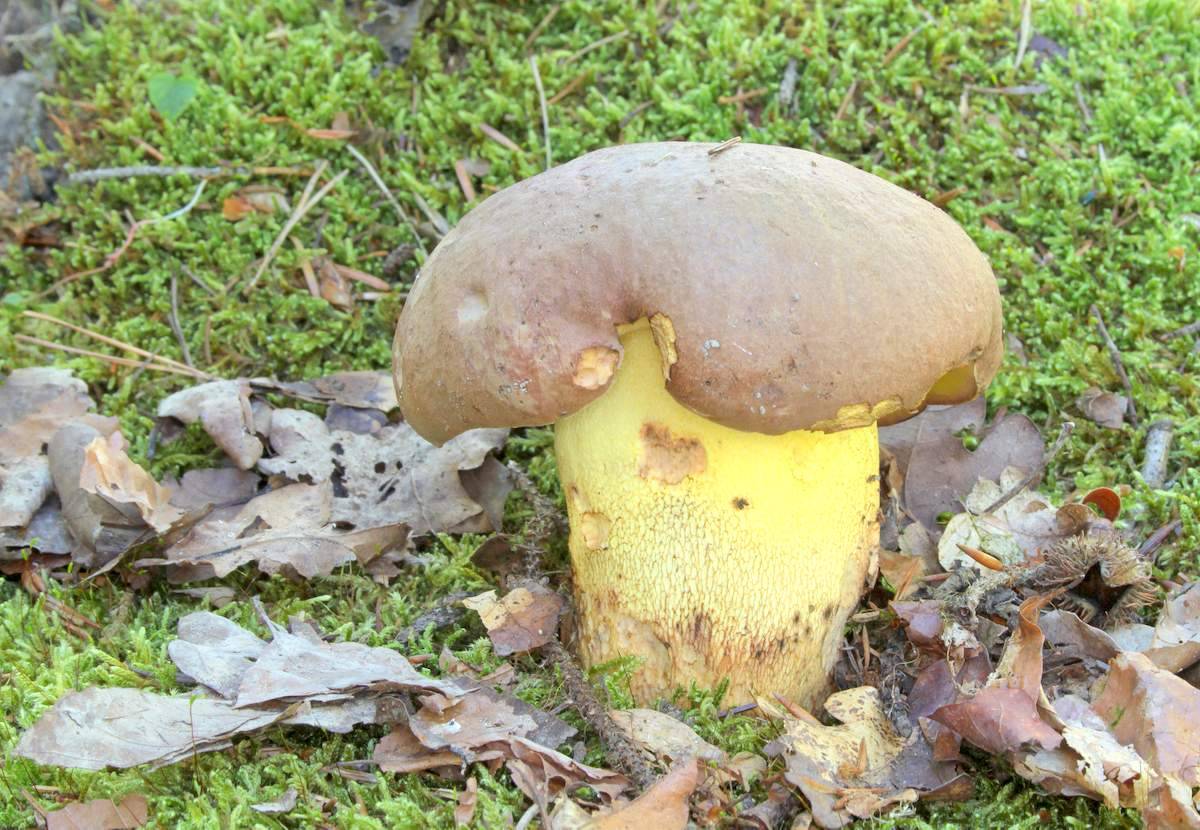
The pulp is dense, rich yellow. At the base of the leg, the color of the pulp is pink-brown or brown. In the cap above the tubes, the flesh is blue, its taste and smell are pleasant. The pores are small, rounded, at a young age they are golden yellow, then golden brown.When pressed, the pores become bluish. Spores are smooth, ellipsoid-fusiform, honey-yellow in color. Spore powder of olive-brown hue.
The leg is 6-12 centimeters long and 2-3 centimeters in diameter. There is a mesh on the leg, it disappears with age. The color of the leg is lemon yellow, at the bottom it becomes red-brown. Its shape is clavate or cylindrical, the base of the leg is pointed. When touched, the leg turns blue.
Distribution of boletus adnexa
Boletus girls are rare mushrooms. They grow mainly in colonies. Fruiting from June to September. The boletus adnexa are found mainly in areas with a moderately warm climate. They grow in mixed and deciduous forests. These mushrooms prefer calcareous soil.

The similarity of boletus maiden with other mushrooms
Boletus adventitious are similar to semi-white mushrooms, but the latter are distinguished by a light ocher-colored cap, a black-brown lower part of the stem and a carbolic odor. Also boletus boletus outwardly resembles an edible boletus semispidatochkovy with white pulp, which is extremely rare in spruce mountain forests.
Other mushrooms of this genus
The false satanic mushroom or boletus is a conditionally edible mushroom. The hat is 5-10 centimeters in diameter, but can reach 20 centimeters. At first, its shape is semicircular, and then it becomes convex-outstretched, often with sharp protruding edges. The color of young mushrooms is milky-coffee or grayish, and in adults it becomes dark pink or brown with a reddish tint. The pulp is dense, thick, blue. The height of the leg is 4-8 centimeters with a thickness of 2-6 centimeters. The shape of the leg is cylindrical, the lower part is narrowed. The color of the leg is yellowish with red or red-brown spots, its lower part is brownish.

The false satanic mushroom is a fairly common species among the sick. These mushrooms grow in oak forests. They bear fruit from November to January. They grow in groups. Wolf boletus is eaten after preliminary boiling for 10-15 minutes.
Boletus Fechtner is an edible mushroom. The diameter of its cap is 5 to 15 centimeters. Its shape is hemispherical, but over time it becomes flat. The color is silvery white or pale brown. The height of the leg is 4-15 centimeters, with a thickness of 2-6 centimeters, with a thicker lower part. The color of the leg is red-brown, there may be a mesh pattern.
Boletus Fechtner grows on calcareous soil. These mushrooms are found in deciduous forests, in the Caucasus and the Far East. Fruiting time is from June to September. Fechtner's boletus can be consumed in salted, fresh and canned form; in terms of taste, they belong to the 3rd category.

Where do boletus grow and what they look like
These mushrooms can be easily distinguished by a swollen stem, which has a thickening in the base area or in the middle, often covered with a kind of mesh. The mushroom cap has the shape of a hemisphere or pads. The hat has a dry and smooth surface and a little velvet to the touch. Each type of boletus has its own distinctive features.
Boletus are cosmopolitan mushrooms that are found on all continents except Antarctica and Australia. Certain species (for example, porcini mushroom) are not afraid of cold climates, and therefore grow on the borders of Iceland and Chukotka. Only boletus is more hardy to low air temperatures. This species was introduced to New Zealand, Africa and South America along with conifers. Northern Europe, Africa and America are natural habitats.
Certain types of mushrooms are listed in the Red Book. For example, the royal boletus is listed in the Red Book of Ukraine. Now this species is rare, like lipoviks and some other species.
Useful properties of boletus
Forest boletus is a natural and widely available storehouse of essential vitamins and many beneficial properties. The composition of the mushroom pulp is presented:
- thiamine;
- riboflavin;
- pantothenic acid;
- pyridoxine;
- folates;
- ascorbic acid;
- alpha tocopherol;
- vitamin PP;
- niacin;
- potassium;
- calcium;
- magnesium;
- sodium;
- gray;
- phosphorus;
- chlorine;
- iron;
- cobalt;
- manganese;
- rubidium;
- fluorine;
- chrome;
- zinc.
Useful properties are also due to the presence in the composition of a sufficiently large amount of digestible carbohydrates, essential and nonessential amino acids, which are involved in metabolic processes, oxidative and reduction reactions occurring in the human body. Vitamins "A", "B1", "C" and "D" promote the growth of nails and hair, and minerals are necessary for bones and joints, to prevent osteoporosis and anemia, to maintain normal functioning of the heart muscle.
Borovik the Beautiful
In the composition of this mushroom there are substances toxic to the human body that cause upset of the gastrointestinal tract. But at the same time, this disorder does not cause significant harm to health and does not lead to death. This boletus has a reddish or brown hat. There are fluff on the surface of the cap. The height of the leg reaches 15 cm. The most characteristic signs of the fungus are the bloody color of the pores, and also the fact that when cut, the pulp of the mushroom turns from yellow to blue-blue. The species is most common in the western United States under conifers.
Borovik subordinate (Borovik maiden)
Boletus appendage (Latin Boletus appendiculatus) is a tubular, edible mushroom of the genus Boletus (Boletus) of the Boletaceae family. A rare mushroom that grows from June to September, in deciduous and mixed forests.
Hat
The diameter of the cap of the Borovik subordinate is from 70 to 200 mm. At a young age, the cap of the mushroom has a semicircular shape. With age, the fungus becomes convex. The surface is velvety, matte, becomes naked with age, slightly longitudinally fibrous. The skin is practically not removed. Borovik's cap is yellow-brown, red-brown and brown-brown in color.
The tubules are dense, up to 40 mm in length. The pores are small and rounded. The color of the tubes in young mushrooms is golden yellow; with age, the mushroom becomes golden brown. When pressed, they acquire a bluish-greenish tint.
Spore powder, spores
Spores are smooth, ellipsoid-fusiform. The size of the spores is 10-15 x 4-6 microns. They are honey-yellow in color. Spore powder, olive brown.
Leg
Leg height from 60 to 120 mm, diameter from 20 to 30 mm, cylindrical or club-shaped. The base of the stem is conically pointed, rooted in the ground. The leg of the boletus is mesh, with the age of the fungus the mesh pattern disappears. The color of the leg is closer to the cap of lemon-yellow color, to the bottom it is red-brown.
Pulp
The pulp is firm, intense yellow. At the base of the peduncle is brownish or pinkish-brown. Has a pleasant mushroom taste and aroma. Turns blue on the cut.
When and where it grows
Rare mushroom. Prefers to grow in groups of 3 to 7 pcs. The boletus is found mainly in deciduous and mixed forests from June to September. Likes to grow in regions with warm temperate climates. Forms mycorrhiza with oaks, hornbeams and beeches. It is also noted in the mountains among the fir trees. Attachment to calcareous soil is noted in the literature.
Similar species
The boletus adnexa is similar to the edible Semi-white mushroom (Latin Boletus impolitus), which can be distinguished by its light ocher cap, black-brown leg at the bottom and carbolic odor.
Poisonous, inedible and false boletus species
Inedible, but non-toxic species, are not capable of causing severe poisoning, but they have an unpleasant taste. Poisonous species are characterized by the presence of toxic substances that can provoke severe damage to internal organs and tissues.
Variety le Gal
Vol.légaliae is a poisonous species with a hemispherical, smooth, pinkish-orange cap, whitish or yellowish flesh that turns blue on the cut. The area of the leg is swollen, with a surface covered with a reddish mesh. Tubules with an adherent tooth and red pores.
Spores are olive brown, fusiform.
Boletus purple
Vol.purpureus is a low-toxic, but inedible variety with a hemispherical, then convex cap with uneven edges, covered with a velvety, reddish-brown skin with rare blackish specks. The pulp is of a fleshy type, with a very high density, immediately turning blue and then bright red when cut. The area of the leg is rather thick, clavate, covered with a dense reddish mesh pattern. The tubules are loose, golden yellow or olive. Spores with an olive tint.

Pink-skinned boletus
Vol.rhodokhanthus is a rare and poorly studied inedible variety,
with a hemispherical, cushion-shaped, prostrate and slightly depressed in the central part of the cap, covered with a smooth or slightly velvety, sometimes slightly sticky, brownish-gray or dirty brownish-yellow skin with a characteristic reddish tint. The soft part with sufficient density, lemon-yellow in color, slightly blue in the cut, with a weak mushroom aroma and bitter taste. The stem is tuberous, often pointed at the very base, yellow in color, covered with a thin, bright red, rather convex mesh or looped pattern. The tubules are light yellow or bright beige-yellow. Olive spores.

Bolet the Beautiful
Vol.рulcherrimus is a poisonous species with a hemispherical, woolly cap of a reddish or olive-brown color. The soft part is quite dense, yellow in color, clearly bluish in the cut.
The area of the leg, swollen, is reddish-brown in color, with a dark reddish mesh. Tubules with an attached tooth, yellow-green, blood-red. The spores are brown, fusiform.
Rooting hurts
Vol.radisans - due to its bitter taste, the mushroom belongs to the category of inedible.
It has a hemispherical or convex cap with a protruding leathery-type edging. The skin is whitish, off-gray or brownish-gray, woolly or cracked. The soft part is lemon-yellow in color, turning blue in the cut, with a slight mushroom aroma and an unpleasant bitter taste. The stem is swollen, cylindrical, with a tuberous base, dull yellow or lemon yellow, with a thin, uniformly colored mesh pattern.





